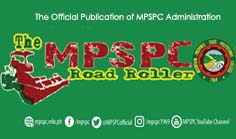RELATIONSHIP OF THE ACADEMIC PERFORMANCE TO THE LICENSURE EXAMINATION FOR TEACHERS PERFORMANCE OF MPSPC BSED GRADUATES
Valerie Kerr P. Guinayen
Introduction
Performance in the board examinations is taken as one of the measures of the quality of a program. If the rate of the first attempt passing is high, it is a good measure of program excellence (Professional Regulation Commission CHED, 2004).
Further, as cited by Hermosisima (2003), one of the most commonly mentioned indicators of quality of higher education programs in the country is the performance of the graduates in the licensure examinations. The licensing examination is one of the last hurdles that a candidate must face in the licensing process. A board has the ultimate responsibility to ensure that the examination meets technical, professional, and legal standards, and, protects the health, safety and welfare of the public by assessing candidates’ abilities to practice competently. Once a candidate has passed a licensing examination, the board must be comfortable granting the license, thus assuring the public that the licensee is minimally qualified to practice at the time of initial licensure.
Today, prospective teachers must clear a series of hurdles to obtain and maintain a teaching certificate – one of which is to pass the Licensure Examination for Teachers (Libman, 2009). Licensure Examination for Teachers (LET) is a test of the overall knowledge and proficiency of prospective teachers to provide a reliable structure, which the practice of prospective teachers can be measured and proven, and it gives access to continuing growth and development.
Licensing is required to ensure that the only qualified teachers can be hired. This builds anxiety not only among examinees but more so far schools who turn out prospective teachers with different majors. Obviously, the National examination for teachers stirs competitive against, since it augurs possible employment, salary or appointment upgrading ranking consideration, and acceptance to the halls of DECS. In fact, passing the LET is the main requirement used by the Department of Education (Dep. Ed.) for all teacher education graduates to earn the title professional teacher.
In addition, implications permeate school standards and pride for garnering honors from percentage passers (Philippine Journal of Education, 2005).
The belief that testing can improve the quality of the teaching force is based on the assumption that the tests are used as good measures of the competencies needed for effective teaching and that their salutary effects on training and selection are not outweighed by negative consequences for supply (including, for example, eliminating competent teachers from the pool and dissuading some from considering teaching).
The performance scores in the LET reflect the abilities of the teacher examinees. Thus, having low percentage of LET passers indicates low quality pre-service teacher education in the country. Also, poor performance in LET may lead to further slide of the educational standards of a country. If this alarming trend will not be aided, the country will be seeing more classrooms with no teachers in schools despite an oversupply of teacher education graduates who end jobless or else volunteer teachers in remote areas (Performance of SDSSU In the Licensure, 2012).
On the other hand, high percentage of LET passers contributes greatly to the accreditation of college programs of a certain college or university. This aside from adding zest within the vicinity of school academe, is the reason why schools offering education courses crave for high percentage of LET passers. (Philippine Journal of Education, 2005).
In the context of the Teacher Education Institutions (TEIs), this points to the performance of teacher education graduates in the LET as an accepted indicator of quality education provided by the TEIs.
Mountain Province State Polytechnic College, a teacher-training institution was created under Republic Act 7182. A trend analysis on the performance in MPSPC on the Licensure Examination for Teachers from 1999 to 2003 revealed that MPSPC ranked 83rd out of 463 state universities and colleges nationwide, just one level lower to qualify as a high performing institution. However, for the next years, there seems to be an erratic performance of LET takers for the BEEd and BSED programs. In 2010, MPSPC graduated the first batch who were covered under CMO 30. The institutional passing rate for the Licensure exam for teachers in the secondary level given on September 26, 2010 for Bontoc Campus is 12.26% ; for Tadian Campus , 23.53% compared to the national passing rate of 25. 86%. On April 2010, LET performance in the Secondary level for the Tadian Campus registered at 6.67%; Bontoc Campus is 18.28 against the national passing rate of 23.32%.Then in the September 2011LET exams, the passing rate slightly rose with the students at Tadian Campus getting 36.48%, Bontoc campus 32.98% against the national passing rate of 31.45%. The same unpredictable trend can be observed with the BEED programs in the later years.
It is underscored in this study that the board ratings of the Teacher Education students are affected by their academic performance and that there are factors affecting their academic performance such as age, gender, and innate capabilities.
Hence, the researcher is interested to conduct this study to determine the correlation between academic performance and LET performance of BSED graduates of the MPSPC.




















